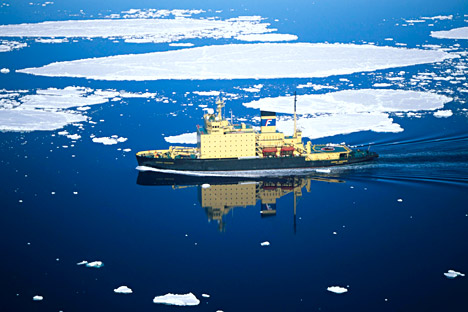
The laser works like a glass-cutting tool, making incisions in the ice in front of an icebreaker to facilitate the passage of the vessel. Source: DPA / Vostock-Photo
While the Arctic remains one of the least explored frontiers on Earth, various new ice protection devices, seismic prospecting technologies and power installations for ships have recently been appearing on the market.
One of the latest Russian inventions is a laser ice cutter, developed by the Moscow-based KURS research institute. Engineers at KURS believe their laser will revolutionize Arctic exploration, helping to increase traffic several-fold along the Northern Sea Route, the main shipping lane passing along the Russian Arctic coast. According to KURS Head Lev Klyachko, the project was based on research conducted by Russian scientists over the past decade and is approaching completion.
The laser works like a glass-cutting tool, making incisions in the ice in front of an icebreaker to facilitate the passage of the vessel. The inventors claim the device will enable the making of wider paths in ice so that icebreakers can escort ships of greater width.
Experts at Rostec State Corporation (a Russian non-profit entity promoting the development of high-tech products) say the laser cutter will be economically profitable, as it will allow for the creation of new shipping lanes and increase traffic volumes.
Vladimir Pushkarev, the director of the Russian Arctic Exploration Institute, also emphasizes the issue of traffic. “If the laser can help speed up the icebreakers traveling along Northern seas, it must be installed,” Pushkarev told RBTH.
The inventors at KURS say their laser cutters will be capable of making incisions and cuts in a layer of ice several meters thick and will help make passages possible for heavy icebreakers, as well as transport vessels. However, famous Russian polar explorer Viktor Boyarsky says the cold temperatures in the Arctic will restore the ice too quickly for the laser to cut through it efficiently.
“As a person who has made numerous expeditions to the Arctic, I simply do not understand how this laser can help navigation,” says Boyarsky. “Granted, the device can cut through ice floes three-meters thick, but the cuts will heal as soon as the ray moves away . . . Nuclear powered icebreakers are the best solution we have and this is not going to change in the foreseeable future. It is hard to imagine transport ships making passages independently, without icebreakers, by simply chipping off the ice with a laser.”
Still, this laser has been noticed by the international scientific community: two years ago, the device was awarded a gold medal at the Inventions Geneva 2013 international exhibition.
The laser-cutter project is being implemented by Schwabe Holding, which is a part of Rostec Corporation. Engineers at Schwabe say the device represents a “breakthrough in Russian laser technologies.” A representative from Schwabe told RBTH that, “we are planning to expand the scope of the laser system, including installing it on lighter vessels to navigate through Siberian rivers.”
The Financial Times has suggested in March that Russia has managed to secure advantages in the Arctic race by not abiding to international environmental standards. However, Schwabe representatives claim the development of the laser cutter and similar high-tech devices is carried out in accordance to all international environmental safety standards.
“Once the development of the laser system is completed, we will conduct all the necessary tests to confirm the device is safe for the environment and for Arctic fauna and flora,” officials from Schwabe told RBTH. They added that the system would not be installed on icebreakers until the tests are passed.
According to Rosatomflot, the owner of Russia's fleet of nuclear icebreakers, Russian vessels carry 15 million tons of cargo annually through the Northern seas. If the new device reaches its full potential, this figure could increase by several times.
All rights reserved by Rossiyskaya Gazeta.
Subscribe
to our newsletter!
Get the week's best stories straight to your inbox